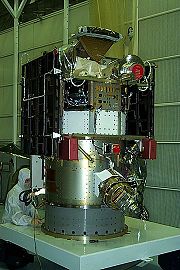
Triana (satellite)
Encyclopedia

NASA
The National Aeronautics and Space Administration is the agency of the United States government that is responsible for the nation's civilian space program and for aeronautics and aerospace research...
satellite proposed in 1998 by then-Vice President
Vice President of the United States
The Vice President of the United States is the holder of a public office created by the United States Constitution. The Vice President, together with the President of the United States, is indirectly elected by the people, through the Electoral College, to a four-year term...
Al Gore
Al Gore
Albert Arnold "Al" Gore, Jr. served as the 45th Vice President of the United States , under President Bill Clinton. He was the Democratic Party's nominee for President in the 2000 U.S. presidential election....
for the purpose of Earth observation. It is intended to be positioned at the Earth's Lagrangian point
Lagrangian point
The Lagrangian points are the five positions in an orbital configuration where a small object affected only by gravity can theoretically be stationary relative to two larger objects...
, at a distance of 1.5 million kilometers. At this location it will have a continuous view of the Sun-lit side of the Earth.
The satellite's original purpose was to provide a near-continuous view of the entire Earth and make that live image available via the Internet. Gore hoped not only to advance science with these images, but also to raise awareness of the Earth itself, updating the influential The Blue Marble
The Blue Marble
The Blue Marble is a famous photograph of the Earth taken on December 7, 1972, by the crew of the Apollo 17 spacecraft at a distance of about ....
photograph taken by Apollo 17
Apollo 17
Apollo 17 was the eleventh and final manned mission in the American Apollo space program. Launched at 12:33 a.m. EST on December 7, 1972, with a three-member crew consisting of Commander Eugene Cernan, Command Module Pilot Ronald Evans, and Lunar Module Pilot Harrison Schmitt, Apollo 17 remains the...
.

Albedo
Albedo , or reflection coefficient, is the diffuse reflectivity or reflecting power of a surface. It is defined as the ratio of reflected radiation from the surface to incident radiation upon it...
). This data could constitute a barometer for the process of global warming
Global warming
Global warming refers to the rising average temperature of Earth's atmosphere and oceans and its projected continuation. In the last 100 years, Earth's average surface temperature increased by about with about two thirds of the increase occurring over just the last three decades...
. The scientific goals expanded to measure the amount of solar energy reaching Earth, cloud patterns, weather systems, monitor the health of Earth's vegetation, and track the amount of UV
Ultraviolet
Ultraviolet light is electromagnetic radiation with a wavelength shorter than that of visible light, but longer than X-rays, in the range 10 nm to 400 nm, and energies from 3 eV to 124 eV...
light reaching the surface through the ozone layer
Ozone layer
The ozone layer is a layer in Earth's atmosphere which contains relatively high concentrations of ozone . This layer absorbs 97–99% of the Sun's high frequency ultraviolet light, which is potentially damaging to the life forms on Earth...
.
In 1999, NASA's Inspector General
NASA Office of Inspector General
The NASA Office of Inspector General is the inspector general office in the National Aeronautics and Space Administration, the space agency of the United States...
reported that "the basic concept of the Triana mission was not peer reviewed", and "Triana's added science may not represent the best expenditure of NASA's limited science funding."
Congress asked the National Academy of Sciences
United States National Academy of Sciences
The National Academy of Sciences is a corporation in the United States whose members serve pro bono as "advisers to the nation on science, engineering, and medicine." As a national academy, new members of the organization are elected annually by current members, based on their distinguished and...
whether the project was worthwhile. The resulting report stated that the mission was "strong and scientifically vital."
Triana was named after Rodrigo de Triana
Rodrigo de Triana
Rodrigo de Triana was a sailor and the first European since the Vikings known to have seen America. Born as Juan Rodrigo Bermejo, Triana was the son of Morisco hidalgo and potter Vicente Bermejo and Sereni Betancour....
, the first of Columbus
Christopher Columbus
Christopher Columbus was an explorer, colonizer, and navigator, born in the Republic of Genoa, in northwestern Italy. Under the auspices of the Catholic Monarchs of Spain, he completed four voyages across the Atlantic Ocean that led to general European awareness of the American continents in the...
's crew to sight land in the Americas. NASA renamed the satellite Deep Space Climate Observatory (DSCOVR), in an attempt to regain support for the project.
Triana was removed from its original launch opportunity on STS-107
STS-107
-Mission parameters:*Mass:**Orbiter Liftoff: **Orbiter Landing: **Payload: *Perigee: *Apogee: *Inclination: 39.0°*Period: 90.1 min- Insignia :...
(the ill-fated Columbia mission
Space Shuttle Columbia disaster
The Space Shuttle Columbia disaster occurred on February 1, 2003, when shortly before it was scheduled to conclude its 28th mission, STS-107, the Space Shuttle Columbia disintegrated over Texas and Louisiana during re-entry into the Earth's atmosphere, resulting in the death of all seven crew members...
in 2003). The $100 million satellite remained in storage for the duration of the Bush administration.
In November 2008 the satellite was removed from storage and began recertification for a possible launch on board a Delta II
Delta II
Delta II was an American space launch system, originally designed and built by McDonnell Douglas. Delta II is part of the Delta rocket family and was in service from 1989 until November 1, 2011...
or a Falcon 9
Falcon 9
Falcon 9 is a rocket-powered spaceflight launch system designed and manufactured by SpaceX. Both stages of its two-stage-to-orbit vehicle use liquid oxygen and rocket-grade kerosene propellants...
.
As of February 2011, the Obama administration is attempting to secure funding to re-purpose the DSCOVR spacecraft as a solar observatory to replace the Aging Advanced Composition Explorer
Advanced Composition Explorer
Advanced Composition Explorer is a NASA space exploration mission being conducted as part of the Explorer program to study matter in situ, comprising energetic particles from the solar wind, the interplanetary medium, and other sources. Real-time data from ACE is used by the Space Weather...
(ACE) spacecraft.
In Al Gore's
Al Gore
Albert Arnold "Al" Gore, Jr. served as the 45th Vice President of the United States , under President Bill Clinton. He was the Democratic Party's nominee for President in the 2000 U.S. presidential election....
Our Choice, he uses part of the book as an attempt to revive debate on the DSCOVR payload. The book mentions legislative efforts by Senators Barbara Mikulski
Barbara Mikulski
Barbara Ann Mikulski is the senior United States Senator from Maryland and a member of the Democratic Party. Mikulski, a former U.S. Representative, is the longest-serving female senator in U.S...
and Bill Nelson
Bill Nelson
Clarence William "Bill" Nelson is the senior United States Senator from the state of Florida and a member of the Democratic Party. He is a former U.S. Representative and former Treasurer and Insurance Commissioner of Florida...
to try to get the satellite launched.
See also
- STEREOSTEREOSTEREO is a solar observation mission. Two nearly identical spacecraft were launched into orbits that cause them to respectively pull farther ahead of and fall gradually behind the Earth...
- Clouds and the Earth's Radiant Energy SystemClouds and the Earth's Radiant Energy SystemClouds and the Earth's Radiant Energy System is NASA climatological experiment from Earth orbit.The CERES are scientific satellite instruments, part of the NASA's Earth Observing System...
- Advanced Composition ExplorerAdvanced Composition ExplorerAdvanced Composition Explorer is a NASA space exploration mission being conducted as part of the Explorer program to study matter in situ, comprising energetic particles from the solar wind, the interplanetary medium, and other sources. Real-time data from ACE is used by the Space Weather...
External links
- Vice President Gore challenges NASA to build a new satellite to provide live images of Earth from outer space White House press release, March 13, 1998
- ARL-SCRIPPS Atmospheric Research Laboratory at Scripps Institution of Oceanography
- Deep Space Climate Observatory website at NASA Langley
- NASA DSCOVR NASA Science page
- Review of Scientific Aspects of the NASA Triana Mission National Research Council Report, March 3, 2000
- Politics puts $100 Million Satellite on Ice, The Orlando Sentinel, July 15, 2001
- Scorched Earth Robert L. ParkRobert L. ParkRobert Lee Park , also known as Bob Park, is an emeritus professor of physics at the University of Maryland, College Park and a former Director of Public Information at the Washington office of the American Physical Society...
, New York Times, January 15, 2006 - Re-Politicizing Triana, Center for Science and Technology Policy Research, January 15, 2006
- Who Killed The Deep Space Climate Observatory?, Popular SciencePopular SciencePopular Science is an American monthly magazine founded in 1872 carrying articles for the general reader on science and technology subjects. Popular Science has won over 58 awards, including the ASME awards for its journalistic excellence in both 2003 and 2004...
, April 6, 2011

